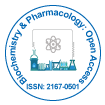
Biochemistry & Pharmacology: Open Access
Open Access
ISSN: 2167-0501
+44-77-2385-9429

ISSN: 2167-0501
+44-77-2385-9429
Perspective - (2024)Volume 13, Issue 2
The efficiency of treatments and patient health are dependent upon the safety and purity of pharmaceutical products. Analytical methods, a collection of advanced procedures intended to identify, measure, and characterize pollutants and impurities are important in providing these attributes. High-Performance Liquid Chromatography (HPLC) is a major analytical technique utilized in the pharmaceutical companies. Components inside a mixture can be identified, separated, and quantified with the use of HPLC. It operates by passing a liquid sample through a column packed with a stationary phase, where different compounds in the sample interact with the stationary phase at varying degrees, leading to their separation. The compounds are then detected, often using Ultra Violet (UV) or Mass Spectrometry (MS) detectors. HPLC is preferred for its high resolution, precision, and ability to handle complex mixtures, making it indispensable for purity analysis.
Gas Chromatography (GC) is another technique, particularly for volatile and semi-volatile organic compounds. GC involves vaporizing the sample and transporting it through a column with a carrier gas. The interaction between the analytes and the column's stationary phase results in separation, with detection typically achieved via Flame Ionization Detection (FID) or mass spectrometry. GC is highly effective in detecting trace levels of impurities and is often used for residual solvent analysis in pharmaceuticals. Mass Spectrometry (MS) is an analytical tool due to its sensitivity and specificity. In order to produce charged molecules or molecule fragments, chemical substances are ionized in MS, and the mass-to-charge ratios of these molecules are then measured. When used with chromatographic techniques like HPLC or GC, MS can provide detailed information about the molecular weight and structure of compounds, advancing in the identification and quantification of impurities.
Spectroscopic methods, including Infrared (IR) and Nuclear Magnetic Resonance (NMR) spectroscopy, are also critical in pharmaceutical analysis. IR spectroscopy measures the absorption of infrared light by molecules, providing information on molecular vibrations and functional groups. This method is valuable for identifying organic compounds and verifying their purity by comparing spectra against standard references. NMR spectroscopy utilizes the magnetic properties of certain nuclei. It provides detailed information about the molecular structure, dynamics of compounds. Proton and carbon-13 (13C) NMR are commonly used to confirm the identity and purity of Active Pharmaceutical Ingredients (APIs) and excipients.
Elemental analysis techniques such as Inductively Coupled Plasma-Mass Spectrometry (ICP-MS) and Inductively Coupled Plasma-Optical Emission Spectroscopy (ICP-OES) are important for detecting and quantifying trace elements and heavy metals. These methods involve ionizing the sample in a plasma source and measuring the emitted light or the mass-to-charge ratios of ions. They provide high sensitivity and precision, ensuring compliance with regulatory limits for elemental impurities. Capillary Electrophoresis (CE) is another technique used to separate ionic species based on their charge and size. In CE, an electric field is applied to a capillary filled with an electrolyte, causing ions to move at different velocities. This method is highly effective for analyzing biomolecules such as proteins, peptides, and nucleotides, and it provides high-resolution separation with minimal sample and reagent consumption.
Microbiological methods such as sterility testing, endotoxin testing, and microbial limits testing are used to detect and quantify microbial contaminants. Sterility testing involves improving the product in nutrient media and observing for microbial growth. Endotoxin testing, often performed using the Limulus Amebocyte Lysate (LAL), detects bacterial endotoxins that can cause pyrogenic reactions. Another important aspect of pharmaceutical analysis is the detection of genotoxic impurities, which can pose significant risks even at low levels. Analytical methods for genotoxic impurities often involve highly sensitive techniques such as liquid chromatography combined with tandem mass spectrometry. These methods are capable of detecting trace levels of genotoxic substances, ensuring that the final product is safe for human use.
Citation: Henry C (2024) Microbiological Techniques in Pharmaceutical Analysis: Preserving Patient Health through Sterility Assessment. Biochem Pharmacol. 13:364.
Received: 27-May-2024, Manuscript No. BCPC-24-33169; Editor assigned: 30-May-2024, Pre QC No. BCPC-24-33169 (PQ); Reviewed: 14-Jun-2024, QC No. BCPC-24-33169; Revised: 21-Jun-2024, Manuscript No. BCPC-24-33169 (R); Published: 28-Jun-2024 , DOI: 10.35248/2167-0501.24.13.364
Copyright: © 2024 Henry C. This is an open-access article distributed under the terms of the Creative Commons Attribution License, which permits unrestricted use, distribution, and reproduction in any medium, provided the original author and source are credited.